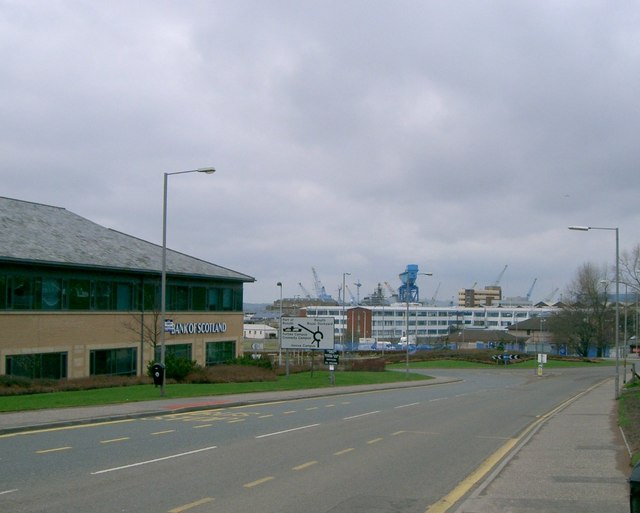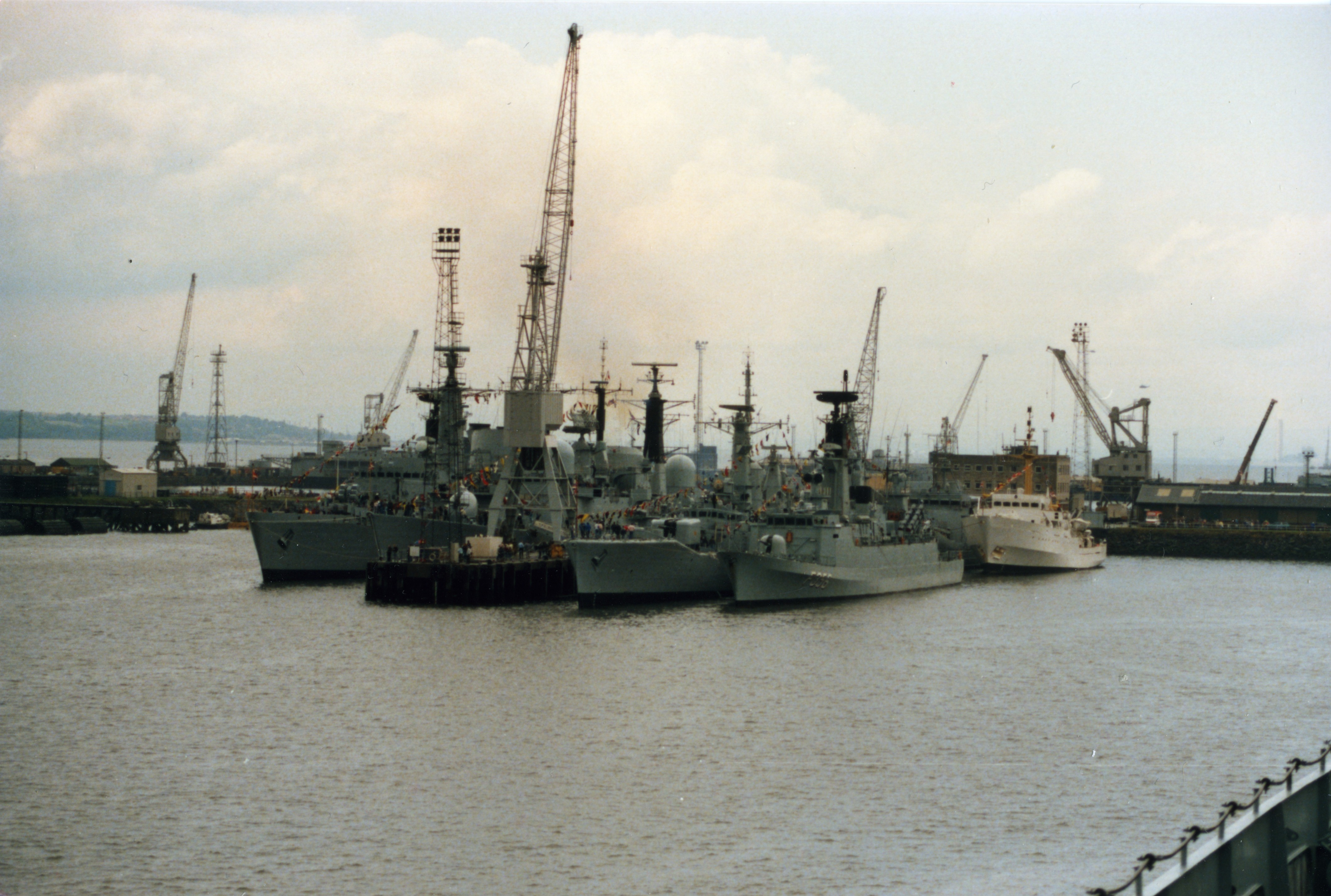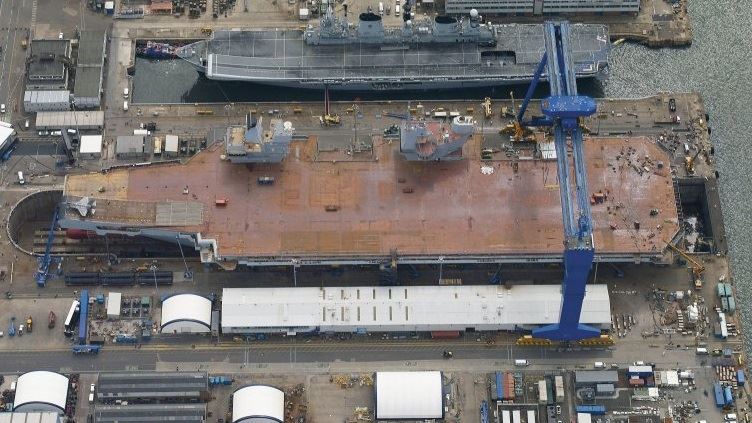Rosyth Naval Dockyard on:
[Wikipedia]
[Google]
[Amazon]
 Rosyth Dockyard is a large naval dockyard on the
Rosyth Dockyard is a large naval dockyard on the
 Construction of the dockyard by civil engineers Easton, Gibb & Son commenced in 1909. At the time, the Royal Navy was strengthening its presence along the eastern seaboard of Great Britain due to a naval arms race with
Construction of the dockyard by civil engineers Easton, Gibb & Son commenced in 1909. At the time, the Royal Navy was strengthening its presence along the eastern seaboard of Great Britain due to a naval arms race with

 Babcock Thorn, a consortium operated by Babcock International and
Babcock Thorn, a consortium operated by Babcock International and
 The Royal Navy's two carriers were constructed across six UK shipyards, with final assembly at Rosyth.
The Royal Navy's two carriers were constructed across six UK shipyards, with final assembly at Rosyth.
'Graveyard' fear as sub's hull is holed
Dunfermline Press, 3 April 2008 {{Admiralty Department, state=collapsed Ports and harbours of Scotland Royal Navy bases in Scotland Organisations based in Fife Royal Navy submarine bases Economy of Fife 1909 establishments in Scotland Port cities and towns of the North Sea Royal Navy dockyards Rosyth
 Rosyth Dockyard is a large naval dockyard on the
Rosyth Dockyard is a large naval dockyard on the Firth of Forth
The Firth of Forth () is a firth in Scotland, an inlet of the North Sea that separates Fife to its north and Lothian to its south. Further inland, it becomes the estuary of the River Forth and several other rivers.
Name
''Firth'' is a cognate ...
at Rosyth
Rosyth () is a town and Garden City in Fife, Scotland, on the coast of the Firth of Forth.
Scotland's first Garden city movement, Garden City, Rosyth is part of the Greater Dunfermline Area and is located 3 miles south of Dunfermline city cen ...
, Fife
Fife ( , ; ; ) is a council areas of Scotland, council area and lieutenancy areas of Scotland, lieutenancy area in Scotland. A peninsula, it is bordered by the Firth of Tay to the north, the North Sea to the east, the Firth of Forth to the s ...
, Scotland
Scotland is a Countries of the United Kingdom, country that is part of the United Kingdom. It contains nearly one-third of the United Kingdom's land area, consisting of the northern part of the island of Great Britain and more than 790 adjac ...
, owned by Babcock Marine, which formerly undertook refitting of Royal Navy
The Royal Navy (RN) is the naval warfare force of the United Kingdom. It is a component of His Majesty's Naval Service, and its officers hold their commissions from the King of the United Kingdom, King. Although warships were used by Kingdom ...
surface vessels and submarines. Before its privatisation in the 1990s it was formerly the Royal Naval Dockyard Rosyth. Its primary role now is the dismantling of decommissioned nuclear submarines. It is also the integration site for the Royal Navy's newest aircraft carriers, the as well as the Type 31 Frigate
The Type 31 frigate, also known as the Inspiration class, and formerly known as the Type 31e frigate or General Purpose Frigate (GPF), is a class of five frigates being built for the United Kingdom's Royal Navy, with variants also being built ...
.
History
 Construction of the dockyard by civil engineers Easton, Gibb & Son commenced in 1909. At the time, the Royal Navy was strengthening its presence along the eastern seaboard of Great Britain due to a naval arms race with
Construction of the dockyard by civil engineers Easton, Gibb & Son commenced in 1909. At the time, the Royal Navy was strengthening its presence along the eastern seaboard of Great Britain due to a naval arms race with Germany
Germany, officially the Federal Republic of Germany, is a country in Central Europe. It lies between the Baltic Sea and the North Sea to the north and the Alps to the south. Its sixteen States of Germany, constituent states have a total popu ...
.
First World War
* In 1903 approval was given with an estimated cost of £3 million for "works" and £250,000 for machinery spread over 10 years. The site consisted of of land, of foreshore, and the main basin would be . This was intended to be large enough for 11 battleships or 22 if doubled up. The yard gained in size and importance during the First World War, with No. 6 Division of the Metropolitan Police set up to patrol it on 1 January 1916 (the Metropolitan Police then provided police for UK dockyards). The first ship todry dock
A dry dock (sometimes drydock or dry-dock) is a narrow basin or vessel that can be flooded to allow a load to be floated in, then drained to allow that load to come to rest on a dry platform. Dry docks are used for the construction, maintenance, ...
at Rosyth was the pre-dreadnought battleship on 28 March 1916.
Interwar years
* as an ammunition store ship between October 1918 and 4 February 1920. * HMS ''Crescent'' (1899) as a harbor depot ship between 1 May 1920 and 17 September 1921. * as a minelayer between February 1918 and January 1919.
World War II
Privatisation
 Babcock Thorn, a consortium operated by Babcock International and
Babcock Thorn, a consortium operated by Babcock International and Thorn EMI
Thorn EMI was a major British company involved in consumer electronics, music, defence and retail. Created when Thorn Electrical Industries merged with EMI in October 1979, it was listed on the London Stock Exchange and was once a constituen ...
, was awarded the management contract for Rosyth dockyard in 1987; with Rosyth Dockyard becoming a government owned, contractor run facility. This contract was awarded in parallel with Devonport Management Limited's contract to run Devonport Dockyard, Plymouth
Plymouth ( ) is a port city status in the United Kingdom, city and unitary authority in Devon, South West England. It is located on Devon's south coast between the rivers River Plym, Plym and River Tamar, Tamar, about southwest of Exeter and ...
. In 1993 the Ministry of Defence
A ministry of defence or defense (see American and British English spelling differences#-ce.2C -se, spelling differences), also known as a department of defence or defense, is the part of a government responsible for matters of defence and Mi ...
announced plans to privatise Rosyth. Babcock International, who had bought out Thorn's share of the original Babcock Thorn consortium, was the only company to submit a bid and after protracted negotiations purchased the yard in January 1997.
Nuclear submarine refitting
In 1984 Rosyth was chosen as the sole location for refitting the Royal Navy's nuclear submarine fleet (a role it was already specialising in), and in 1986 extensive rebuilding commenced to facilitate this new role. However, in 1993, the government switched the refitting role to Devonport Dockyard.Nuclear submarine decommissioning
Seven nuclear submarines were stored at Rosyth in 2007. In 2018, thePublic Accounts Committee
A public accounts committee (PAC) is a committee within a legislature whose role is to study public audits, invite ministers, permanent secretaries or other ministry officials to the committee for questioning, and report on their findings subseque ...
criticised the slow rate of decommissioning of these submarines, with the Ministry of Defence
A ministry of defence or defense (see American and British English spelling differences#-ce.2C -se, spelling differences), also known as a department of defence or defense, is the part of a government responsible for matters of defence and Mi ...
admitting that it had put off decommissioning due to the cost and is currently due to be finalised in 2035.
*
*
*
*
*
*
*
Queen Elizabeth class aircraft carriers
 The Royal Navy's two carriers were constructed across six UK shipyards, with final assembly at Rosyth.
The Royal Navy's two carriers were constructed across six UK shipyards, with final assembly at Rosyth.
Today
Today, a Ministry of Defence site is based at the former dockyard, MoD Caledonia, which holds a small naval garrison. It was due to close by/in 2022, but its future has now been assured. Babcock are currently building the type 31 frigates at the dockyard.Administration of the dockyard
Theadmiral-superintendent
The admiral-superintendent was the Royal Navy officer in command of a larger Naval Dockyard. Portsmouth, Devonport and Chatham all had admiral-superintendents, as did some other dockyards in the United Kingdom and abroad at certain times. The a ...
was the Royal Navy officer in command of a larger Naval Dockyard. The appointment of admiral-superintendents (or their junior equivalents) dates from 1832 when the Admiralty took charge of the Royal Dockyards. Prior to this larger dockyards were overseen by a commissioner who represented the Navy Board
The Navy Board (formerly known as the Council of the Marine or Council of the Marine Causes) was the Regulatory agency, commission responsible for the day-to-day civil administration of the Royal Navy between 1546 and 1832. The board was headqua ...
.
Admiral-Superintendent, Rosyth
Included:'' * Rear-Admiral Sir Henry H. Bruce: June 1915 – April 1920 * Vice-Admiral Sir John F. E. Green: April 1920 – June 1923 * Rear-Admiral Colin Cantlie: September 1939 – April 1944 * Rear-Admiral Henry C. Bovell: April 1944 – April 1947 * Vice-Admiral Sir Angus Cunninghame-Graham: April 1947 – August 1951 * Rear-Admiral John H. F. Crombie: August 1951 – November 1953 * Rear-Admiral Peter Skelton: November 1953 – September 1956 * Rear-Admiral Peter D.H.R. Pelly: September 1956 – November 1957 * Rear-Admiral Walter Evershed: November 1957 – September 1960 * Rear-Admiral Ian G. Aylen: September 1960 – September 1963 * Rear-Admiral John G. Watson: September 1963 – September 1966 * Rear-Admiral William T.C. Ridley: September 1966 – September 1971Port Admiral, Rosyth
* Rear-Admiral William T.C. Ridley: September 1971 – February 1972 * Rear-Admiral Peter White: February 1972 – April 1974 * Rear-Admiral Anthony J. Monk: April 1974 – January 1976 * Rear-Admiral William T. Pillar: January 1976 – November 1977 * Rear-Admiral John R.D. Nunn: November 1977 – January 1980 * Rear-Admiral James E.C. Kennon: January 1980 – August 1981 * Rear-Admiral John C. Warsop: August 1981 – August 1983 * Vice-Admiral Robert R. Squires: August – December 1983 In the Royal Naval Dockyards, admiral-superintendents ceased to be appointed after 15 September 1971, and existing post-holders were renamedport admiral
Port admiral is an honorary rank in the United States Navy, and a former appointment in the British Royal Navy.
Royal Navy
In British naval usage, the term 'port admiral' had two distinct (and somewhat contradictory) meanings, one generic, one sp ...
s.
Note: These officers reported to the Flag Officer Scotland and Northern Ireland.
References
Bibliography
*External links
'Graveyard' fear as sub's hull is holed
Dunfermline Press, 3 April 2008 {{Admiralty Department, state=collapsed Ports and harbours of Scotland Royal Navy bases in Scotland Organisations based in Fife Royal Navy submarine bases Economy of Fife 1909 establishments in Scotland Port cities and towns of the North Sea Royal Navy dockyards Rosyth